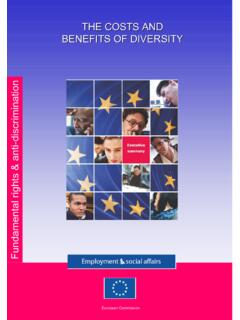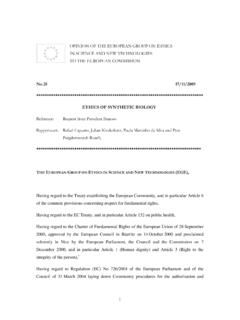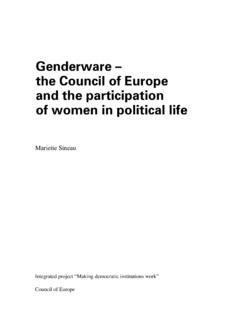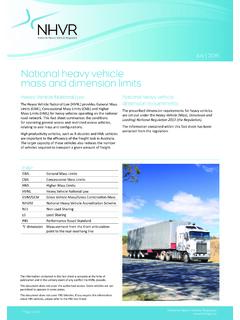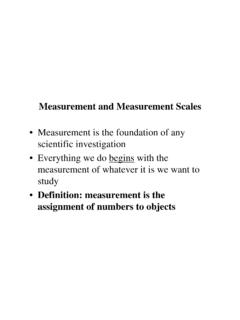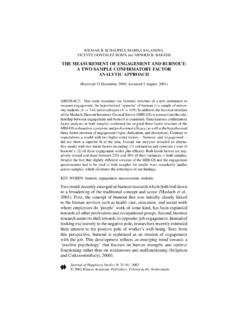Transcription of Measurement and indicators of integration
1 Measurement and indicators of integration Community Relations Measurement and indicators of integration Community Relations Directorate of Social and Economic Affairs Council of Europe Publishing 5 Introduction Measuring social behaviour and social phenomena always is a very challenging task. This is especially true when it comes to evaluating the integration of migrants into their host societies, because it means in fact evaluating two social processes: One cannot look at the migrants alone, but also has to take the members of the host society into consideration. As with any undertaking in social sciences, the evaluation or Measurement of integration has to begin with a definition of the basis terms. In the papers submitted by the experts as well as in the discussion during the meeting it became clear that clear-cut definition of: a. who belongs to the target group of integration policies and b.
2 What exactly is meant by the term " integration " are of great importance. Without common standards as to what is meant by "migrant" and by " integration " all attempts to measure migrants' integration in different countries are likely to be of little meaning. Defining basic terms can at times be complicated but finding common definitions of the crucial terms "migrant" and " integration " is made even more difficult, because national integration policies heavily influence the understanding of "migrant" and " integration ". 1. Concepts of what integration means and is to achieve differ. These differences are reflected in the national policy goals and range from next-to-assimilation to multiculturalism. 2. National integration policies define different target groups for their integration measures: Not everybody who has come from abroad is a member of the target group ( not formally recognized refugees), not everybody who is part of the target group has ever migrated from abroad ( the second generation).
3 6 In addition to this, the national focal points for fields of integration differ according to the situation of migrants in a given country. This has a heavy bearing on the section of indicators or integration . The selection of indicators and the problems of measuring social behaviour were dealt with in an in-depth paper that the consultants presented to the Specialist Group on February 21st 1995. From 4 to 6 October 1995, almost sixty experts from more than twenty different countries were invited by the Council of Europe to gather in Strasbourg in order to evaluate the prospects of better measuring migrants' integration in Europe by using indicators or integration . Their task was not an easy one, but despite the difficulties described, the participants of the meeting have come to a set of common conclusions on indicators of migrants' integration . These conclusions are, on the one hand, based on the sixteen different presentation documented in this volume which deal with national concepts of integration as well as with attempts to measure integration in various countries.
4 On the other hand, they also are the result of the many animated and knowledgeable discussions which, unfortunately, cannot be included as well. The meeting in Strasbourg has shown how much there has already been done in the field of identifying indicators of integration for measuring migrants' integration . Although it has just as well proven the need for more steps to be taken, it has been a very pleasant and fruitful experience. 1. Whose integration is to be examined? One of the major obstacles for finding common ground when discussing the integration of migrants is to define the fundamental terms. Neither " integration ", "migrant" or "migration" are clear-cut terms. International migration, though easily defined as the medium to long-term movement of persons from one country to another involving a change of residence, describes a large variety of phenomena making topologies or classifications necessary. Some of these classifications refer, for instance, to the migrant's (economic or political) reasons to leave his country of origin.
5 Other attempts to categorize migratory movements or migrating persons were made along the lines of regular versus 7 irregular, voluntary versus forced or permanent versus short-term migration. The term "migrant", too, is a broad one: Migrant workers, family members, asylum seekers, political refugees (recognized as such after an administrative procedure) as well as other refugees (accepted or tolerated without any formal procedure) or irregular/illegal immigrants all fall into the category "international migrants". Other definitions - neglecting the requirement of a change of residence and thus a change of the social environment - also include persons participating in international student exchanges, seasonal workers or cross-border commuters. Each discourse on migrants' integration has to take this large spectrum into consideration. Furthermore, it has to, as a first step, define exactly whose integration will be examined.
6 In this context a first problem of criteria for inclusion or exclusion arises. Only the criterion of a change of residence and social environment - thus leaving tourists and commuters out of consideration - may be suitable for compromise. But all other criteria are likely to cause dispute: Does it make sense to look exclusively at regular migrants, because they - from the government's point of view - "deserve" integration into the host society? Would irregular migrants have to be excluded, because their - reluctant -host countries refuse to offer any integration policy measures to them? Or will they have to be included, because they themselves intend to stay for good? How about recognized refugees? Aren't they expected to return to their home countries once the political conditions allow for repatriation? Even more difficult is the case of war refugees or refugees who aren't - for what ever reason - recognized as such, but who, nevertheless, are allowed to stay, because sending them back is considered inhuman or impossible.
7 Defining the "objects" of integration measures and their analysis becomes even more complicated when one takes into account that some countries - with good reason to do so -extend their integration policies to persons who are not migrants in the original sense of the word, because they never moved from one country to another. Especially children and grandchildren of migrants fall into this category. Even though members of this group may have acquired the citizenship of their parents' country of immigration on request or when they were born, they may, nevertheless, be confronted with difficulties due to their ethnic origins. The same is true for adult foreigners who were naturalized. They have obtained a new passport, but they have not changed their ethnic, cultural or religious roots. Neither did their naturalization change their professional qualifications or their language skills. Consequently, they 8 still might - labelled as ethic minorities - be target persons for measures aimed at improving their integration .
8 Another problem of selection is caused by immigrants who come from foreign countries but who either already possess the citizenship of their new home country or acquire it more or less automatically upon arrival. These immigrants certainly have a legal advantage over other migrants, but they nevertheless have to adapt to a society they are not familiar with. Thus, they, too, belong to the target groups for integration measures. This is especially true for so-called ethnic migrants who are descendants of emigrants settling in Eastern Europe several generations ago. Ethnic Germans or ethnic Greeks coming from the former Soviet Union face considerable difficulties of social, economic and cultural adaption despite their cultural roots and their legal privilege. 2. What is integration and who is to define it? A satisfying compromise when identifying target groups will be difficult to reach, not only because of the various types of migrants or because researchers' individual interests differ, but also because of different concepts of integration as reflected in the national integration policies.
9 The member states of the Council of Europe all have their own migratory traditions and migration policies shaping a country's fundamental assumptions on the integration of foreigners. Some countries have long standing immigration traditions (France, United Kingdom), whereas others have only just recently become countries of immigration (Spain, Italy). A third group has few problems with immigration, but faces considerable difficulties with indigenous ethnic minorities (Romania, Slovak Republic). And even although some groups of countries share common migratory histories - such as the countries recruiting "guest workers" in the 1960s - all governments pursue different approaches when designing their integration policies. Among the more "experienced" countries of immigration, for example, the Netherlands are characterized by a very active integration and "minorities" policy, whereas Germany's approach is more restrictive when it comes to legal and political integration of foreigners.
10 The national policies often reflect different definitions of what is meant by 9 " integration ". While the term itself means "joining parts (in) to an entity" its practical interpretation and social connotation may vary considerably: "Assimilation" as well as "multicultural society" may be considered synonyms or descriptions of (successful) integration . Thus, all forms of cultural or social behaviour ranging from completely giving up one's background to preserving unaltered patterns of behaviour are covered by the term of integration . This problem of definition, of course, has a bearing on measuring integration , because the requirements for success in assimilation are much more difficult to meet than requirements for multicultural co-existence in a society which remains indifferent about other people's rites or customs. This, in turn, is important when it comes to comparing the integration of migrants in different states and societies: Since different definitions of what integration means form the basis of the national policies for improving migrants' integration , the standard of when integration can be considered successful varies.
